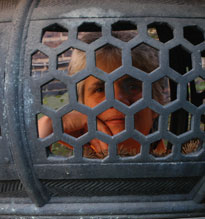Janet
M. Monge
- Keeper of Physical Anthropology
- Associate Director and Manager, Casting Program, University
of Pennsylvania Museum
- Adjunct Associate Professor, Department of Anthropology,
University of Pennsylvania
Recent
Projects
As co-curator, with Dr. Alan Mann, of the Museum's forthcoming
traveling exhibition, "Surviving: The Body of Evidence," I have been active in meeting
with the exhibition planning and development team. The
project is funded by the largest exhibition grant ever awarded
to The University of Pennsylvania Museum of Archaeology and
Anthropology: a three year, $1.7 million continuing grant
from the National Science Foundation. The 3,000-square-foot
exhibition will explore the process and consequences of human
evolution in the context of its implications for our daily
lives by using hands-on interactive devices, flexible exhibit
designs with multimedia capabilities, and interactive "Web-chats"
with an open community of scholars. It is scheduled to premiere
at the Penn Museum in 2007, before traveling for three years
to nine widely distributed institutions, ultimately serving
a national audience of several million viewers.
I continue as Associate Director and Manager of the Casting
Program (a non-profit small business venture with world-wide
sales distribution to museums and universities for research
and teaching) that stores over 3000 molds and casts representing
every phase of human evolution. During the summer of
2004, I traveled to France to mold the newest Neandertal fossils
excavated to add to this expanding collection.
With American Section curator (and former Museum director)
Dr. Jeremy Sabloff, I received a prestigious National Science
Foundation grant for the "Native
Voices: Past and Present - University of Pennsylvania
Research Experience for Undergraduates" project, which
will enable us to work with Native American college students
on collections here at the Penn Museum. Six students arrived
in the Spring semester 2005 and joined the undergraduate student
ranks taking a full series of classes. Each of the Native
students partnered with a Penn undergraduate student in this
research endeavor. The project will extend for 3 years
(2005-2008).
In 2002-2003, I concentrated on the establishment of a virtual
archive of CT scans of many of the major skeletal collections
at the Museum. This work was done in collaboration with
P.T. Schoenemann (Department of Anthropology) and with the
assistance of the Department of Radiology at the Hospital
of the University of Pennsylvania. The research project
was funded by a grant from the University Research Council.
To date, over 200 skulls, primarily from the Morton
Collection of Crania (dated from circa 1830), have been scanned.
In addition, many of the Museum's primate collections are
part of the archived CT scans and arrangements have been made
to scan 25 chimpanzee skulls curated at the American Museum
of Natural History, New York. All of these materials
will be available for all interested scholars worldwide to
download and study as part of their own research projects.
A web site for the dissemination of the data is currently
being constructed and is available at http://grape.anthro.upenn.edu/~lab/pennct/.
Preliminary results of this endeavor have been presented
at several professional meetings. My own research interest
in the project stems from the use of the scans for comparative
purposes to the study of Human Evolution, specifically in
the understanding of the cranial-facial morphology and dentition
of Neandertals.
|


|